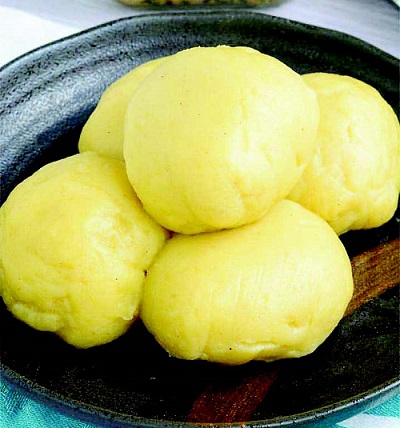
This is the second part of the article published Friday, October 28, 2022 issue of the paper.
TAKE HOME
In conclusion, it is not dangerous to eat fufu at 4 pm or after. We have created a lifestyle -change diseases by giving up or ignoring what generations before us ate. A good time to back in time and bring back a healthy lifestyle! Any food that takes a longer time to break down the glucose and fructose to be absorbed by the blood is truly healthy.
Hence, fufu is the deal! Juxtaposing this with rice which only takes 45 minutes to be absorbed by the blood, thus increases the risk of diabetes.
The GI is a measure of how quickly carbs are digested. Hence, the longer it takes carbohydrate food to digest, the better for our health as Africans. I will opt for fufu or kokonte and most of our local diets which are more resistant starch inclined than any light food anytime. Unless the light is rich in resistant starch or had gone through retrogradation.
This is because fufu has a glycemic index of 55. Additionally, the longer it takes the food to digest the better as compared to those that can digest easily as they can increase your sugar level. The reality is that not all starches are created equally. Though fufu is a starchy food, it is resistant to starch and belongs to the type two groups. Type 2 starches are indigestible because they are compact, which makes it hard for digestive enzymes to break them down. Eating fufu is like eating a fiber diet. Besides the cassava and green plantain all belong to the type 2 class of resistant starch, hence, eating fufu is eating resistant starch and not the other starches you know.
Dr Osman further said: “It is a bad practice to eat heavy food as breakfast since the intestines close during sleeping hours and opens slowly,” he said. He is right about some heavy foods. But fufu is different. Fufu as a resistant starch is a type of carbohydrate that doesn’t get digested in your small intestine. Instead, it ferments in your large intestine and feeds beneficial gut bacteria.
This explains why when you eat fufu or kokonte after some hours when you vomit, you will see the undigested fufu or kokonte again. Besides, fufu has no issue with the intestine. Eating fufu rather benefits the intestine. This is supported by several studies on resistant starch and gut health.
For instance, two studies (Wang et al. 2001; Topping et al. 2003) confirmed that resistant starch feeds the friendly bacteria in our intestines, thus taking a positive effect on the type of bacteria and their number. Also, the fact that the food is light does not mean is good for your health. Remember that, rapidly and slowly digested foods rather tend to increase your sugar.
RECOMMENDATIONS
There’s no formal recommendation for the intake of resistant starch. However, in four studies (Birt et al. 2013; Wang et al. 2019; Maziarz, M. 2013; Maki et al. 2012) where the Study participants naturally received 10–60 grams per day. Significant health impacts were found with a daily intake of at least 20 grams, but an intake as high as 45 grams per day was also marked as safe. Additionally, (Birt et al. 2013; Maki et al. 2012) also found that among Americans, several people get about 5 grams each day, some Europeans may get 3–6 grams, and the daily intake of Australians ranges from 3–9 grams.
Two studies (Chen et al. 2010; O’Keefe et al. 2015) also agreed that the average daily intake for Chinese people is about 15 grams. For rural South Africans 38 grams of resistant starch per day.
In Africa and Ghana, one article by Yakubu, T (2015) explained that people who consume whole grains and unrefined food products are likely to consume about 30-40 g/day. It is estimated that the acceptable daily intake of resistant starch may be as high as 45 grams in adults, an amount exceeding the total recommended intake of dietary fiber of 25-38 grams per day. The dietician encouraged individuals to have a greater consumption of foods that naturally contain resistant starch. This call is necessary in our part of the world, especially because people are increasingly resorting to more refined foods rather than unrefined ones.
From the literature, I found that though these are all high-carb foods as we know in the Ghanaian foods, for those on a very low-carb diet, you can avoid them. Additionally, some still can eat some, especially if they are on a low-carb diet with carbs in the 50–150- gram range. However, considering weight loss, having high blood sugars, and digestive problems, then resistant starch appears good for you.
The health benefits of resistant starch have engineered many people to opt for them now. Resistant starch is a type of nutrient that can boost digestion, prevent diseases, and promote weight loss. While most starches are digested and broken down, resistant starch will pass through you unchanged.
Resistant starch keeps your colon healthy. The good bacteria in your large intestine act to turn resistant starch into short-chain fatty acids, the most important of which is butyrate.
Cooking potatoes, pasta, beans, and rice and allowing them to cool in the refrigerator before eating are good. Reheating these items after they have cooled off won’t affect the levels of resistant starch. Apart from already espoused as resistant starch, we can as well get more resistant starch in our Ghanaian diets by cooking other starchy foods and allowing them to cool before eating.
Wang et al.(2015) found that resistant starch occurs when some starches lose their original structure due to heating or cooking. If these starches are later cooled, a new structure is formed. The new structure is resistant to digestion and leads to health benefits. Sonia et al.(2015) research has shown that resistant starch remains higher after reheating foods that have previously been cooled. However, you may feel that these foods taste best freshly cooked. In that case, find a compromise that works for you. You might choose to sometimes cool these foods before eating them, yet other times eat them freshly cooked.
NB:
Prof. Nyarkotey has strict sourcing guidelines and relies on peer-reviewed studies, academic research institutions, and medical associations to justify his write-ups. My articles are for educational purposes and do not serve as Medical advice for Treatment. I aim to educate the public about evidence-based scientific Naturopathic Therapies.
The author is a Professor of Naturopathic Healthcare and President of Nyarkotey College of Holistic Medicine & Technology (NUCHMT)/ African Naturopathic
BY PROF. RAPHAEL NYARKOTEY OBU




